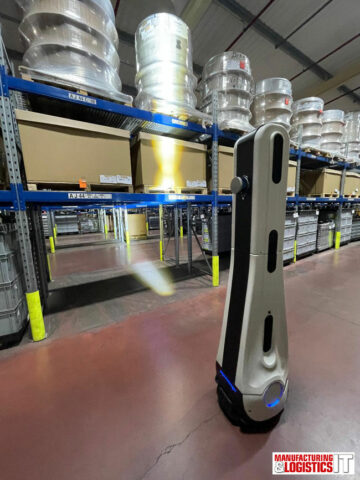Eight in ten (83%) of manufacturing firms in the UK have had a software investment fail to meet expectations, according to new research.
The new 2023 State of Digital Adoption report from technology company, Userlane, reveals that the average manufacturer has spent over £1.7 million on new software investments in the last year.
Manufacturing firms are grappling with technology adoption challenges
The most common reasons for failed software investments are letting the project get too big (24%), poor planning and preparation (24%), and problems with integration (20%).

Overall, more than half (57%) of manufacturing companies rate themselves as only ‘somewhat effective’ at making investments in software, with Userlane’s report highlighting the scale of poor digital adoption – the process of accepting, using and maximising technology.
What’s more, two-thirds (69%) of manufacturing leaders feel their organisation has a digital skills gap.
According to the research, the most common software adoption challenges are:
- Increase in IT support queries (35%)
- Higher training costs (35%)
- Higher costs associated with maintaining old/outdated technologies (30%)
- Resistance from employees towards adopting new technologies (26%)
- Lack of employee skills and knowledge to effectively utilise digital tools (24%)
Manufacturers struggle to measure digital transformation success
While almost all (91%) manufacturing firms prioritise digital adoption, 89% say they’re struggling to improve it. Interestingly, Userlane found that IT (69%) are more likely to be held responsible for improving digital adoption than any other team, including executive leadership, HR, and learning and development.
And while 98% say they currently measure the success of their digital transformation projects, the research found there is no dominant approach. Just over a third (35%) evaluate the financial impact and cost-effectiveness of the project, while 33% track improvements in data quality and process accuracy, and 28% measure employee satisfaction.
Poor software adoption is hurting employee wellbeing and productivity
The report found that six in ten manufacturing employees see stress-free software usage as essential to their overall happiness at work, with 65% linking it to productivity.
Despite this, the majority (93%) of employees reported difficulties in using software, resulting in each employee losing an average of 2.61 hours per week due to software-related challenges. For a business of 5,000 employees, this equates to more than 600,000 hours of wasted working time every year.
Manufacturers remain bullish on digital transformation
Six in ten (60%) UK manufacturers are planning to increase their digital transformation budget in the next 12 months, with 15% anticipating an uplift of more than 20%. On average, budgets will increase by 8%.
Hartmut Hahn, CEO of Userlane, commented: “The manufacturing industry holds huge potential for transformation through technology. But it’s quite common for business leaders to assume that people will naturally grasp how to use new technology, only to find themselves disappointed when the expected results don’t appear. Overlooking the needs of employees during software adoption not only affects their experience and efficiency but also impacts the return on technology investments and disrupts digital transformation efforts.
Our research indicates that 96% of manufacturing employees are eager to acquire new digital skills – a positive outlook for the industry. To aid them in their learning and development aspirations, it’s crucial to simplify the digital adoption process. A promising solution to this challenge involves the implementation of a Digital Adoption Platform (DAP). DAPs seamlessly integrate with the software employees engage with, and they can be coupled with analytics tools to monitor and assess digital adoption across hundreds of applications.”
- SEO Powered Content & PR Distribution. Get Amplified Today.
- PlatoData.Network Vertical Generative Ai. Empower Yourself. Access Here.
- PlatoAiStream. Web3 Intelligence. Knowledge Amplified. Access Here.
- PlatoESG. Automotive / EVs, Carbon, CleanTech, Energy, Environment, Solar, Waste Management. Access Here.
- PlatoHealth. Biotech and Clinical Trials Intelligence. Access Here.
- ChartPrime. Elevate your Trading Game with ChartPrime. Access Here.
- BlockOffsets. Modernizing Environmental Offset Ownership. Access Here.
- Source: https://www.logisticsit.com/articles/2023/09/13/manufacturers-remain-bullish-on-digital-transformation,-despite-eight-in-ten-reporting-failed-software-investments
- :has
- :is
- :not
- 000
- 12
- 12 months
- 15%
- 2023
- 35%
- 7
- a
- accepting
- According
- accuracy
- acquire
- across
- Adopting
- Adoption
- Aid
- All
- almost
- also
- an
- analytics
- analytics tools
- and
- anticipating
- any
- appear
- applications
- approach
- ARE
- AS
- assess
- associated
- assume
- At
- average
- BE
- Big
- budget
- Budgets
- Bullish
- business
- Business Leaders
- but
- by
- CAN
- ceo
- challenge
- challenges
- commented
- Common
- Companies
- company
- Costs
- coupled
- crucial
- Currently
- data
- data quality
- Despite
- Development
- difficulties
- digital
- Digital Transformation
- dominant
- don
- due
- during
- each
- eager
- effectively
- efficiency
- efforts
- Employee
- Employee Satisfaction
- employees
- engage
- equates
- essential
- evaluate
- Every
- executive
- expectations
- expected
- experience
- FAIL
- Failed
- feel
- financial
- Find
- firms
- For
- found
- from
- gap
- get
- grasp
- had
- Half
- Have
- Held
- highlighting
- holds
- HOURS
- How
- How To
- hr
- HTTPS
- huge
- Hundreds
- Impact
- Impacts
- implementation
- improve
- improvements
- improving
- in
- Including
- Increase
- indicates
- industry
- integrate
- integration
- investment
- Investments
- involves
- IT
- IT Support
- jpg
- just
- knowledge
- Last
- Last Year
- leaders
- Leadership
- learning
- letting
- likely
- linking
- losing
- maintaining
- Majority
- Making
- Manufacturer
- Manufacturers
- manufacturing
- manufacturing industry
- maximising
- measure
- Meet
- million
- Monitor
- months
- more
- most
- needs
- New
- New technologies
- next
- no
- of
- on
- only
- organisation
- Other
- Outlook
- over
- overall
- People
- per
- planning
- platform
- plato
- Plato Data Intelligence
- PlatoData
- poor
- positive
- potential
- preparation
- prioritise
- problems
- process
- productivity
- project
- projects
- promising
- quality
- queries
- Rate
- reasons
- remain
- report
- Reported
- Reporting
- research
- responsible
- resulting
- Results
- return
- Reveals
- s
- satisfaction
- say
- Scale
- seamlessly
- see
- simplify
- SIX
- skills
- skills gap
- Software
- solution
- spent
- State
- Struggle
- Struggling
- success
- support
- T
- team
- Technologies
- Technology
- ten
- than
- that
- The
- the UK
- their
- Them
- themselves
- There.
- they
- Third
- this
- Through
- time
- to
- too
- tools
- towards
- track
- Training
- Transformation
- two-thirds
- Uk
- Uplift
- Usage
- use
- using
- week
- wellbeing
- when
- while
- will
- with
- Work
- working
- year
- zephyrnet












